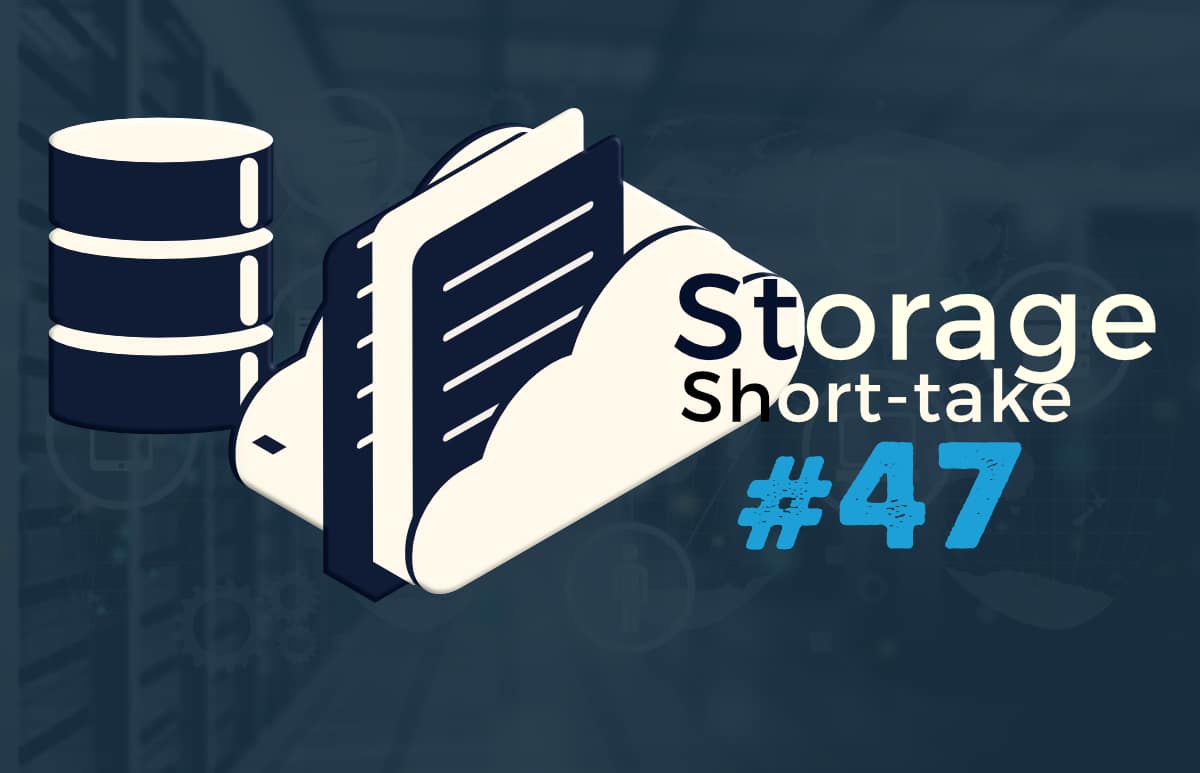
LinkedIn spam has gotten pretty bad. But as this Short Take will be published just before the 2022 Flash Memory Summit, I'll say it here in case someone has a legitimate reason to contact me through that platform:
Unfortunately, due to prior obligations, I will not be in attendance for this year's FMS. I do highly recommend that you attend if it fits into your schedule, though, as there are a lot of very interesting subjects being discussed according to the agenda.
As always, links were live at the time of publication.

Storage Media and Technology
Starting off with some big news: Intel is apparently killing off Optane for good. There are impacts to this decision that go far beyond simply eliminating a product line. It raises questions to the future of Persistent Memory (PM) and all that touches. Vast Data wasted no time with their announcement in response. As usual, Chris Mellor's take is entertaining and informative.
Here's an interesting joint project between LSU, Ohio State, and Rensselaer Polytechnic Institute (RPI): They're joining forces for a project on computational storage. "The main research issues we will study focus on how to effectively exploit the computing capabilities and efficiently utilize the limited resources on device hardware."
Interested in DNA Storage? You may want to take a look at this academic article that breaks down the technology and the promise for large-scale archival storage.
TechRadar has listed off their Top 10 SSDs for PC. Anecdotally, this tracks with some friends of mine who independently ran reliability tests on many of these devices. The notable absent contender? Western Digital.
New research on DNA Storage is showing promise for "write-once and rewritable memory for heterogenous data." Even better, it's showing that it can be erased in a "permanent, privacy-preserving manner."
If you have access to ACM's "Human-Computer Interaction" SIG (I don't), you can get access to an article on "how [DNA Storage] can be applied to facilitate interactions that are meaningful, ethical, and socially sustainable." To me, this is interesting because it's an intersection of my academic research career that I left years ago and my current storage interests. I'll be interested to see what - if any - insights this line of inquiry reveals in the future.
Backblaze has established a reputation for doing pretty good testing on hard drive failure. They've done a blog on a comparison of major drives between 4TB and 14TB, but the real value of the blog is to explain the difference between projected life expectancy and actual life expectancy curves.
Supply chain issues are very difficult. After some time where there was a fear about the availability of NAND Flash, we're now in an overstock situation. You can expect prices to drop further (though with inflation I'm not sure how much of a bargain you'll really find). Chances are they'll overcorrect, and you may want to buy rather than wait as it may become difficult to get SSDs in about a year or so (just a guess).
Cyberattacks are now the #1 cause of data loss. This, despite the number of ransomware attacks appear to be slowing.
Researchers at the Korea Advanced Institute of Science and Technology (KAIST) have a working prototype of disaggregated memory using "DirectCXL." It's predominantly a roll-your-own solution, more of a proof-of-concept, but it does show some very interesting implementations of a concept that has been discussed for a while now.
If you've been curious about seeing a hands-on lab to collect memory allocation and utilization information for Optane, WWT has the site for you.
Storage Companies in the News
Topping our Storage Companies in the News is the jaw-dropping public shaming of Nutanix by MinIO. MinIO accuses Nutanix of distributing MinIO's object storage technology as part of their software stack without disclosing to users. Chris Mellor's comments are spot-on, too. MinIO maybe working on pest control, but they've also announced the ability to run MinIO Object Storage on Google Cloud Platform, so they're not just playing defense.
[Update. Before publication time, Nutanix issued an apology to MinIO.]Ever wonder how Dropbox's storage works? It's one of the few exabyte-scale storage systems, and they have their own special sauce called Magic Pocket as a solution to do it.
Samsung is now sampling their 16GB GDDR6 DRAM. I didn't see what the MSRP is likely to be, though.
How does encryption work in AWS backup? StorageNewsletter has an article (read it before it goes behind a paywall).
Synology is expanding its own C2 Cloud Backup tool. From the description, it looks interesting and I think I'm going to dive into this a bit more. They say it'll "provide protection and restoration for an unlimited number of desktops and laptops through full-device backups of Windos and Mac systems."
Western Digital and Sony Interactive Entertainment have released the first official Playstation 5 M.2 SSD. It comes in 1TB and 2TB flavors.
This was inevitable. I've been saying for years that "SmartNICs" and "Computational Storage" were two sides of the same coin. Here we are, right on cue: Fungible is announcing that they're testing computational storage on their SmartNIC DPUs.
Western Digital's 22TB drives are now available. Now, before you start drooling at the capacity, keep in mind that these drives are best for long-term, low-access data. Anything this big will need to be in a RAID level of 6 at the minimum, which means at least 5 drives in a pool.
Micron has announced that it's begun production of its 232-layer NAND. Micron claims that it's at least 50% faster than their existing 176-layer products with 100% more write bandwidth.
Synology announced an important security issue with Samba which affects Samba 4.13 and later that's not yet resolved.
Associations, Standards, and Conferences
Jon Hass, Chair of DMTF, has decided to retire and go do other interesting things with his life. He's one of those people with a strong presence behind the scenes that make the technology that millions of people use without ever knowing it.
The OpenFabrics Alliance Workshop 2023 will be in person, April 11-13, 2023 in Columbus, Ohio. At least it's not in California or Portland.
Alexandra Saavedra has a blog summarizing her thoughts on the first SmartNIC Summit held in April (I was not there; I was off in Moab wondering where my wheels went). Obviously, it's a rehash of her company's own presentation, but there are some ideas in here worth exploring.
The SNIA Storage Developer Conference (Sept 12-15) agenda has now been published.
Congratulations to Eli Tiomkin of NGD Systems for being appointed to the SNIA Board of Directors!
Webinars, Blogs, and Conferences
The Q&A to SNIA's xPU Accelerator Offload Functions webinar is now posted.
Speaking of SNIA, the Storage Life on the Edge: Accelerated Performance Strategies webinar is available for on-demand viewing. One of the things they talk about is data locality and processing at the storage itself (computational storage).
The third webinar in the accelerator series, xPU Deployment and Solutions Deep Dive, will be held on August 24, 2022 at 10a PT.
I'm starting to really like Chin-Fah Heoh's blogs. He writes on a number of topics (mostly storage related) and his perspective is one that combines inter-related concepts that aren't often joined (a writer after my own heart!). His article on WORM (Write Once, Read Many) and MinIO is a really good case in point.
Ray Luchessi has moved his blog site from the consultancy location to his RayOnStorage site. Update your feeds. If you really like getting into the weeds, Ray's your guy.
Employment News
Still not sure if this is a useful segment or not. I'll try a couple more times but I could see that this would turn out poorly for me as people think that I'm hiring: I'm not.
This is just a PSA for anyone interested in storage-related work and openings that I happen to chance across. Please do not contact me directly about these positions or candidates.
AMD is hiring a Senior Solutions Architect - Networking and Storage. (Disclosure: I work at AMD)
Amazon Web Services is looking for a Software Development Engineer for AWS EBS (Elastic Block Store). Though, if you don't know what "EBS" stands for, you're probably not the right person for the job...
AWS is also hiring for:
- Storage Specialist (Startups)
- Storage Specialist US ISV
- Sr. Storage Specialist in the US Southeast (though they spelled it "Southest," so your mileage may vary on that one)
Mainframes aren't dead, not by a long shot. VSE Corporation is looking for a Mainframe Storage Administrator in Durham, NC as well as Baltimore, MD.
Bonus Round
ArchitectingIT has a new ebook out - Essential Features of Container-Native Storage 2022. It's $695.00 and written by people who definitely know their stuff about storage (this is not a paid plug - I just respect the work they do).
This is pretty cool. Craiyon is an AI engine that draws images from natural language input. It's a lower-resolution version of Dall-E 2, but since that requires joining a waitlist I didn't bother. I put in "photorealistic high definition snow capped mountains with glaciers" and this is what it came up with:





Compare that to photos I took in Alaska a couple years ago:


And you'll see it's really, really close (you'll notice that the quality is not there yet on the AI-generated images, but that's only a matter of time).
The quality isn't as good (or as fast) as This Person Does Not Exist, but that site is all about one-off random images over which you have no control or creative input. When the two capabilities combine, though, it'll be really hard to trust what we see.

Comments
just my opinion on Optane, Intel blindly presumed that larger, lower cost memory could solve problems. This was true up to the 90’s. Since then, properly designed systems could run fine on available memory. Yet there continued to be serious problems in poorly designed applications that could not be solved by more memory, or larger systems (more cores), because they could not use the cores already available. ie, not properly multi-threaded.
What would help single-threaded apps is very low-latency memory, which can be made, only more expensive, and will have lower capacity. all of this can be acceptable if we let go of the ancestral perceived need for more memory
If you perceive the Optane solution as simply memory, then I think you have a very good point. Optane was not as fast as DRAM, not by a long shot. In fact, it was between 4-5x slower than typical DRAM latency speeds. DRAM, however, is volatile and as a result does not make for a very reliable capacity tier.
The full promise of Optane (and Persistent Memory in general) to add in an additional tiering layer. Instead of jumping from 140ns to 100us, it provided a nice sweet spot at around the 1us level where you could have really fast NVM and yet still reach the outer boundaries of byte-addressable load-store capabilities. Because this is an ecosystem solution, though, you need the synchronization across the board. It’s like trying to build a really robust race car, but one component at a time. If you’re going to rapidly increase the power plant, you need to improve the brakes at the same time. You need the control systems to be upgraded at the same time, and so on.
But it’s a chicken-and-the-egg problem. In order to help develop that ecosystem, the drives needed to be ready and stable. That took a very long time to do, though, and it appears the market got tired of waiting.